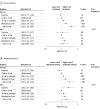Timing and Length of Nocturnal Sleep and Daytime Napping and Associations With Obesity Types in High-, Middle-, and Low-Income Countries
- PMID: 34190997
- PMCID: PMC8246307
- DOI: 10.1001/jamanetworkopen.2021.13775
Timing and Length of Nocturnal Sleep and Daytime Napping and Associations With Obesity Types in High-, Middle-, and Low-Income Countries
Erratum in
-
Error in Funding/Support.JAMA Netw Open. 2021 Aug 2;4(8):e2124602. doi: 10.1001/jamanetworkopen.2021.24602. JAMA Netw Open. 2021. PMID: 34347064 Free PMC article. No abstract available.
Abstract
Importance: Obesity is a growing public health threat leading to serious health consequences. Late bedtime and sleep loss are common in modern society, but their associations with specific obesity types are not well characterized.
Objective: To assess whether sleep timing and napping behavior are associated with increased obesity, independent of nocturnal sleep length.
Design, setting, and participants: This large, multinational, population-based cross-sectional study used data of participants from 60 study centers in 26 countries with varying income levels as part of the Prospective Urban Rural Epidemiology study. Participants were aged 35 to 70 years and were mainly recruited during 2005 and 2009. Data analysis occurred from October 2020 through March 2021.
Exposures: Sleep timing (ie, bedtime and wake-up time), nocturnal sleep duration, daytime napping.
Main outcomes and measures: The primary outcomes were prevalence of obesity, specified as general obesity, defined as body mass index (BMI; calculated as weight in kilograms divided by height in meters squared) of 30 or greater, and abdominal obesity, defined as waist circumference greater than 102 cm for men or greater than 88 cm for women. Multilevel logistic regression models with random effects for study centers were performed to calculate adjusted odds ratios (AORs) and 95% CIs.
Results: Overall, 136 652 participants (81 652 [59.8%] women; mean [SD] age, 51.0 [9.8] years) were included in analysis. A total of 27 195 participants (19.9%) had general obesity, and 37 024 participants (27.1%) had abdominal obesity. The mean (SD) nocturnal sleep duration was 7.8 (1.4) hours, and the median (interquartile range) midsleep time was 2:15 am (1:30 am-3:00 am). A total of 19 660 participants (14.4%) had late bedtime behavior (ie, midnight or later). Compared with bedtime between 8 pm and 10 pm, late bedtime was associated with general obesity (AOR, 1.20; 95% CI, 1.12-1.29) and abdominal obesity (AOR, 1.20; 95% CI, 1.12-1.28), particularly among participants who went to bed between 2 am and 6 am (general obesity: AOR, 1.35; 95% CI, 1.18-1.54; abdominal obesity: AOR, 1.38; 95% CI, 1.21-1.58). Short nocturnal sleep of less than 6 hours was associated with general obesity (eg, <5 hours: AOR, 1.27; 95% CI, 1.13-1.43), but longer napping was associated with higher abdominal obesity prevalence (eg, ≥1 hours: AOR, 1.39; 95% CI, 1.31-1.47). Neither going to bed during the day (ie, before 8pm) nor wake-up time was associated with obesity.
Conclusions and relevance: This cross-sectional study found that late nocturnal bedtime and short nocturnal sleep were associated with increased risk of obesity prevalence, while longer daytime napping did not reduce the risk but was associated with higher risk of abdominal obesity. Strategic weight control programs should also encourage earlier bedtime and avoid short nocturnal sleep to mitigate obesity epidemic.
Conflict of interest statement
Figures

Comment in
-
Die Erste Seite.MMW Fortschr Med. 2021 Jul;163(13):3. doi: 10.1007/s15006-021-0035-0. MMW Fortschr Med. 2021. PMID: 34240346 Free PMC article. German. No abstract available.
References
-
- Finucane MM, Stevens GA, Cowan MJ, et al. ; Global Burden of Metabolic Risk Factors of Chronic Diseases Collaborating Group (Body Mass Index) . National, regional, and global trends in body-mass index since 1980: systematic analysis of health examination surveys and epidemiological studies with 960 country-years and 9.1 million participants. Lancet. 2011;377(9765):557-567. doi:10.1016/S0140-6736(10)62037-5 - DOI - PMC - PubMed
-
- Centers for Disease Control and Prevention . Unhealthy sleep-related behaviors—12 states, 2009. MMWR Morb Mortal Wkly Rep. 2011;60(8):233-238. - PubMed
Publication types
MeSH terms
LinkOut - more resources
Full Text Sources
Medical

